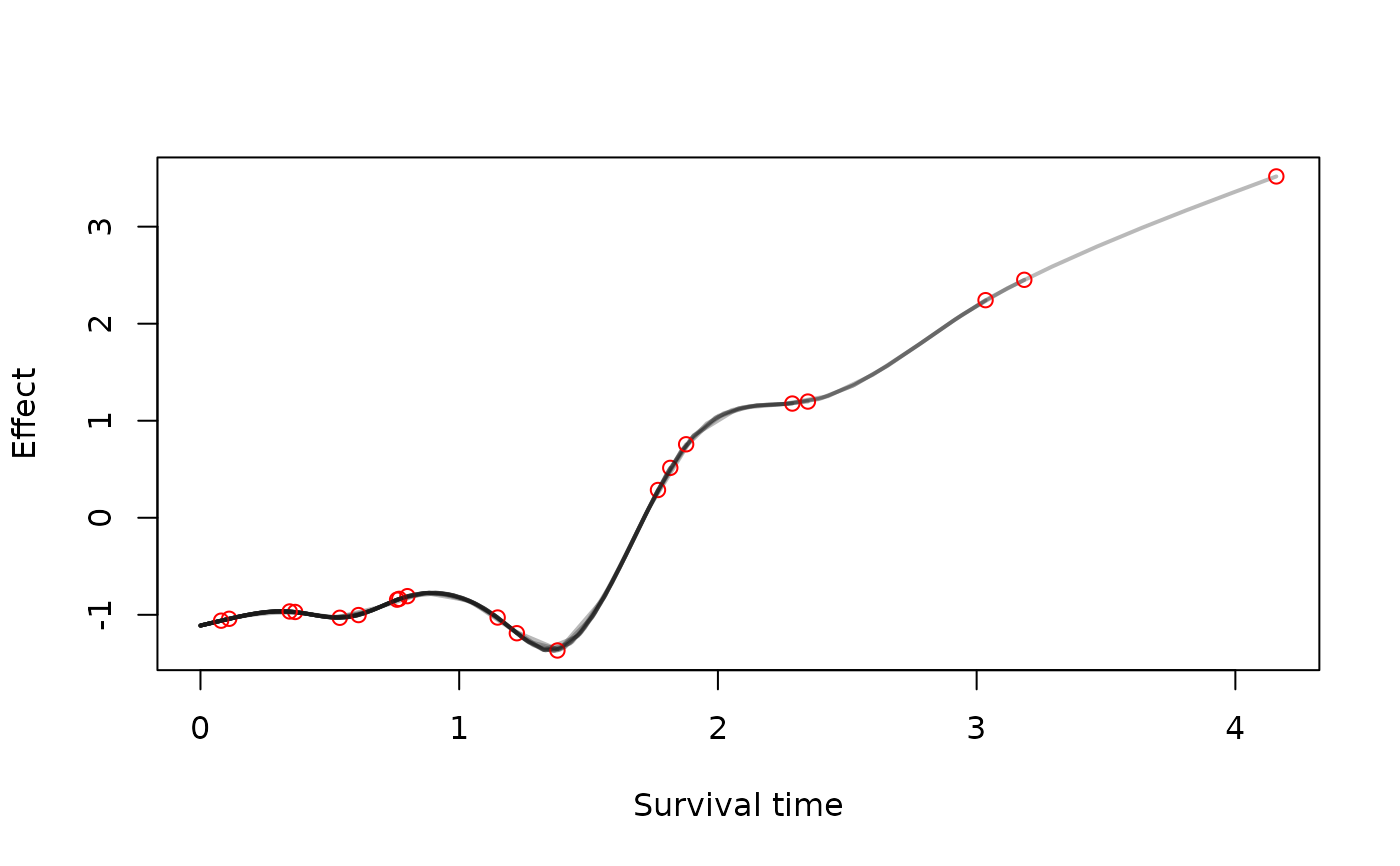Survival Model Transformer Function
surv.transform.RdThis function takes a bamlss.frame and computes design matrices of model terms
based on a time grid for time-dependent structured additive predictors in a survival context.
Note that this transformer function is usually used internally by function bamlss
and is the default transformer function using the cox_bamlss family object.
The time grid design matrices can be used to construct the full structured additive predictor for each time point. This way it is possible to solve the integrals that are part of, e.g., a Newton-Raphson updating scheme, numerically.
See the example section on how to extract the time grid design matrices.
surv_transform(x, y, data, family,
subdivisions = 100, timedependent = "lambda",
timevar = NULL, idvar = NULL, is.cox = FALSE,
alpha = 0.1, ...)Arguments
- x
The
xlist, as returned from functionbamlss.frameand transformed by functionsurv_transform, holding all model matrices and other information that is used for fitting the model.- y
The model response, as returned from function
bamlss.frame.- data
The data.frame that should be used for setting up all matrices.
- family
A bamlss family object, see
family.bamlss. In this case this is thecox_bamlssfamily object.- subdivisions
How many time points should be created for each individual.
- timedependent
A character vector specifying the names of parameters in
xthat are time-dependent. Time grid design matrices are only computed for these parameters.- timevar
A character specifying the name of the survival time variable in the data set.
- idvar
Depending on the type of data set, this is the name of the variable specifying identifier of individuals.
- is.cox
Should the
bamlss.framebe set up for a Cox type survival model.- alpha
A value for the intercept of a parameter names alpha. Typically the association parameter of a longitudinal and survival process in a joint model.
- ...
Arguments passed to function
bamlss.engine.setup.
Value
A bamlss.frame including the time grid design matrices.
See also
Examples
library("survival")
#>
#> Attaching package: ‘survival’
#> The following object is masked from ‘package:bamlss’:
#>
#> Surv2
set.seed(111)
## Simulate survival data.
d <- simSurv(n = 20)
## Formula of the survival model, note
## that the baseline is given in the first formula by s(time).
f <- list(
Surv(time, event) ~ s(time) + s(time, by = x3),
gamma ~ s(x1) + s(x2)
)
## Create the bamlss.frame.
bf <- bamlss.frame(f, family = "cox", data = d)
## Lambda is the time-dependent parameter.
print(bf)
#> 'bamlss.frame' structure:
#> ..$ call
#> ..$ model.frame
#> ..$ formula
#> ..$ family
#> ..$ terms
#> ..$ x
#> .. ..$ lambda
#> .. .. ..$ formula
#> .. .. ..$ fake.formula
#> .. .. ..$ terms
#> .. .. ..$ model.matrix
#> .. .. ..$ smooth.construct
#> .. ..$ gamma
#> .. .. ..$ formula
#> .. .. ..$ fake.formula
#> .. .. ..$ terms
#> .. .. ..$ model.matrix
#> .. .. ..$ smooth.construct
#> ..$ y
#> .. ..$ Surv(time, event)
#> ..$ delete
## Apply the transformer.
bf <- with(bf, surv_transform(x, y, data = model.frame,
family = family, is.cox = TRUE, subdivisions = 25))
## Extract the time grid design matrix for term s(time).
X <- bf$x$lambda$smooth.construct[["s(time)"]]$fit.fun_timegrid(NULL)
dim(X)
#> [1] 500 9
## Compute fitted values for each time point.
grid <- attr(bf$y[[1]], "grid")
gdim <- c(length(grid), length(grid[[1]]))
b <- runif(ncol(X))
fit <- X %*% b
fit <- matrix(fit, nrow = gdim[1], ncol = gdim[2], byrow = TRUE)
plot(as.vector(fit) ~ unlist(grid), type = "n",
xlab = "Survival time", ylab = "Effect")
for(j in seq_along(grid)) {
lines(fit[j, ] ~ grid[[j]], lwd = 2, col = rgb(0.1, 0.1, 0.1, alpha = 0.3))
points(grid[[j]][gdim[2]], fit[j, gdim[2]], col = "red")
}
